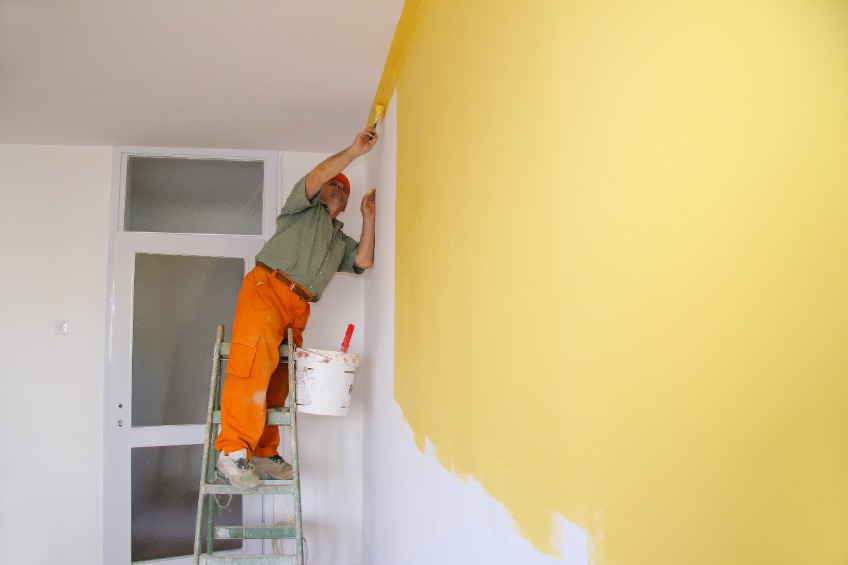
Decorating can be a nightmare at the best of times. If you’re a homeowner, you’ll be no stranger to figuring out what to do with a room full of furniture and spending twice the time prepping surfaces than actually painting them.
If you’re a landlord, it’s tempting to wait until your properties are empty before decorating them, as this makes things a lot simpler. But what if you have long term tenants and the decorating is long overdue?
In this post, we’ll look at your options for decorating a tenanted property and give you tips for decorating while your tenants are in situ.
Should you Decorate Whilst you Have Tenants?
This really is a question only you can answer. Many landlords wait until the property is empty to decorate it. This is a fine strategy and if you have short term tenancies, or you naturally have new tenants every few years, then there’s no reason why this wouldn’t work for you. If you’re selling up or wanting to advertise the property to new tenants, then it is likely worth waiting until the property is empty.
But remember, your property is your tenant’s home. If the paint is peeling and it hasn’t been decorated for a few years, it stands to reason that your tenant might like the décor to be refreshed. If your business model is reliant on long term tenants, then you’ll want to do what you can to keep your tenants happy and comfortable and that usually includes keeping the property and its décor in good condition.
Letting Tenants Decorate your Rental Property
One option when it comes to decorating with tenants in situ is to allow the tenants to decorate the property themselves. If you have long term tenants this can go a long way to helping the tenants feel at home. When the tenant is able to decorate to their own tastes, they are likely to feel more invested in the property as a long-term housing solution.
This solution may not be for everyone and there’s a lot to consider. Check out our article on letting tenants decorate your rental property if you think this could work for you:
Working With the Tenant to Decorate
If you’ve decided that you should decorate the property while the tenant is in situ, it’s important to include them in the project. Depending on what’s being done and the rooms that need decorating, it can be quite disruptive, so you’ll need to find a date that works well for your tenant. It is often customary to wait until a tenant is going away on holiday and to get the decorating done when they’re away from the property. However, not all tenants will be happy with this solution.
It’s also considerate to include the tenant in the choice of décor if it’s going to be different to what they currently have. If you’re just refreshing a magnolia wall then it’s not a big deal, but if you’re going with a different shade, it’s worth discussing with the tenant so they feel included in your decision. Many tenants living in magnolia properties add colour and character to their living space through their furniture, soft furnishing, and accessory choices. If you suddenly change the colour from magnolia, it may impact how the property looks with their furniture and accessories, so it’s worth taking the time to work with the tenant on a colour scheme.
Choosing a Colour Scheme for Your Rental Properties
As we said in the previous paragraph, you may want to deviate from your existing colour scheme. It is common for landlords to want to keep their properties neutral colours, but we’ve come a long way from cream and magnolia on that front. There are lots of choices now when it comes to keeping the property fresh and neutral. We’ve covered this in greater detail in our landlord’s guide to redecorating.
What if Your Tenant Doesn’t Want You to Decorate?
It may be the case that your tenant doesn’t want you to decorate. There could be many reasons for this. Maybe the tenant thinks it will be disruptive, or they just aren’t in a good place to deal with this type of project at this time. For example, if they have young children, they might want to wait until the children are a little older.
Whatever the reason, you should always respect your tenant’s wishes. They are the ones living in the property so if they don’t feel it needs a refresh just yet, consider it an expense spared. If you’re keen to get the decorating done for a sale valuation or for the next tenant or something along those lines, you’re better off waiting until the property is empty and decorating it then.
Do Tenants Have to let you Decorate?
Your tenants don’t have to let you decorate. Your tenant’s obligation is to allow you to carry out repairs and maintenance, and decoration doesn’t generally fall into that category.
If you really want to decorate and your tenant doesn’t want you to, you will have to work with the tenant to understand why they don’t want it to happen. Decide if you really need to decorate right now or if it can wait, or work with the tenant to find a way forward that you can both agree on that will cause less disruption for them.
Do Landlords Have to Decorate a Property if a Tenant asks for it?
As we’ve said in the above paragraph, a landlord’s obligation is to keep the property in good structural condition. It should be free of mould, the tenant should be able to live comfortably and free from disruption, and the home should be fit for human habitation. The décor doesn’t really fall into that category, so a landlord doesn’t ordinarily have to decorate if the tenant asks for it.
However, it may be more of a grey area in cases where there are damp or similar situations. If the property has mould or damp, this needs to be dealt with and that usually involves re-decorating or painting the affected area to prevent the re-growth of mould.
While a landlord doesn’t have to decorate a property if a tenant asks for it, the landlord should still consider the request. Long term tenants may want the property to look nice for them to be able to feel at home, and a refusal to decorate for long term tenants could lead to them leaving for a more attractive property.
Who Should Pay for the Re-decoration at a Rental Property?
The answer to this question depends on a few factors, but the first factor that should be taken into consideration is why the property needs re-decorating in the first place.
If you’re talking about a lick of paint or a refresh, this is the landlord’s domain. The landlord is responsible for the décor and so the expense rests with the landlord.
If the property needs re-decorating because the tenant has caused damage to the existing décor, then the tenant would usually be expected to contribute to the costs of the re-decoration. If, for instance, there’s writing on the walls from children, accidental damage caused by large spills, staining from hair dye or spilled paint or chemicals, or maybe a hole in the wall, the tenant would be expected to cover the costs to make this right. This is only if you know the damage was caused by your current tenants. Note that you wouldn’t expect them to pay for the re-decoration of the entire room, just the area that needs repairing and re-decorating.
Damage like this usually comes to light at the end of a tenancy and is usually deducted from the deposit. If you pay to put this damage right ahead of a tenancy ending, you should retain receipts and invoices demonstrating how much you paid to put the damage right.
Remember that wear and tear is different to damage. You would reasonably expect wear and tear to walls and floors over time, especially if you’re using light paint like magnolia. If there are a few scuffs or a bit of peeling paint, this is likely to fall under the category of wear and tear and it isn’t something you would expect a tenant to pay for.
When it comes to decorating while you have a tenant in situ, the expense for this would usually fall to the landlord, however, there are many landlords and tenants out there who split the costs of decorating. Where landlords and tenants have a good relationship it’s often the case that the landlord will allow the tenant to decorate and will contribute half the costs. This allows the tenant a bit more say over the décor and the standard of the materials used, but also benefits the landlord as it keeps the property in good condition. There is no obligation for the tenant to contribute, and not all tenants would be suited to this kind of arrangement, but it is an option for some landlords.
If you have any more questions about decorating a tenanted property, leave a comment below.



